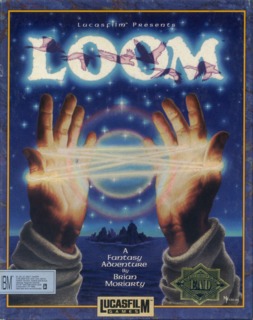An adventure game inspired by the music of 'Swan Lake'. It shouldn't work, but this clever title proves otherwise.
The game begins on Bobbin's seventeenth birthday, where Hetchel is also punished with 'transcendence' for teaching Bobbin. It is then that a swan visits the guild and casts a 'transcendence' spell over all of them, except Bobbin, and leads them off through a rift in the sky. Learning that a Third Shadow is about to be cast over the world, Bobbin sets out with his distaff - a big stick which allows him to 'weave' - and find the flock.
Despite having one of the most complex plots in the history of adventure gaming, the control system is far simpler than previous LucasFilm entries. While being the fourth game to use LucasFilm's patented SCUMM 'point-and-click' system, it does away with the typical functions of 'Pick up', 'pull', 'talk to' and so on that we normally see in these games. Rather, Bobbin directly interacts with the environment and through a series of spells. The spells themselves are based on musical 'drafts' - short musical phrases based on a combination of notes. While some basic spells and their applications are described in the 'Book of Patterns' (included with the set), more are learned as you progress through the game. You begin with only a handful of notes with which to construct your spells, earning more as you solve more of the game's dilemmas. Different objects and people are susceptible to different spells, and most of the puzzles involve working out the appropriate application of a spell in the right place. These drafts change from game to game, instantly giving "LOOM" replayability.
Graphically, the game was quite impressive for its day. Making full use of the limited colour spectrum available to it, ported over from the EGA version on the PC. (It wasn't until a later re-release on the PC that it took advantage of the power of VGA). However, it is in the audio department that this title really shines. Driven largely by the Tchaikovsky score to 'Swan Lake', the game makes full use of the Amiga 500's 4Channel Stereo-Sound. Indeed, this was the game that prompted me to make the upgrade to a full 1 MB of RAM to fully take advantage of this 'new' generation of gaming.
While certainly dated by today's standards in terms of sound and graphics, "LOOM" led the way with its unique 'point and click' engine. Simplifying LucasFilm Games' already basic interface, the game became a forerunner to the more intuitive gaming interfaces that we currently see on the market. Using sound and vision, and a complex backstory, "LOOM" was an instantly immersive game that still has replay value today. Severely underrated in its day, "LOOM" has every right to be considered a classic alongside "Maniac Mansion" and the bona classic that was to follow it, "The Secret of Monkey Island" (1990).
Highly recommended.

